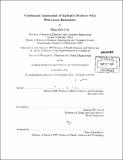| dc.contributor.advisor | Rosalind W. Picard. | en_US |
| dc.contributor.author | Poh, Ming-Zher | en_US |
| dc.contributor.other | Harvard University--MIT Division of Health Sciences and Technology. | en_US |
| dc.date.accessioned | 2012-01-12T19:29:13Z | |
| dc.date.available | 2012-01-12T19:29:13Z | |
| dc.date.copyright | 2011 | en_US |
| dc.date.issued | 2011 | en_US |
| dc.identifier.uri | http://hdl.handle.net/1721.1/68456 | |
| dc.description | Thesis (Ph. D.)--Harvard-MIT Division of Health Sciences and Technology, 2011. | en_US |
| dc.description | Cataloged from PDF version of thesis. | en_US |
| dc.description | Includes bibliographical references (p. 145-159). | en_US |
| dc.description.abstract | Epilepsy is a neurological disorder characterized predominantly by an enduring predisposition to generate epileptic seizures. The apprehension about injury, or even death, resulting from a seizure often overshadows the lives of those unable to achieve complete seizure control. Moreover, the risk of sudden death in people with epilepsy is 24 times higher compared to the general population and the pathophysiology of sudden unexpected death in epilepsy (SUDEP) remains unclear. This thesis describes the development of a wearable electrodermal activity (EDA) and accelerometry (ACM) biosensor, and demonstrates its clinical utility in the assessment of epileptic seizures. The first section presents the development of a wrist-worn sensor that can provide comfortable and continuous measurements of EDA, a sensitive index of sympathetic activity, and ACM over extensive periods of time. The wearable biosensor achieved high correlations with a Food and Drug Administration (FDA) approved system for the measurement of EDA during various classic arousal experiments. This device offers the unprecedented ability to perform comfortable, long-term, and in situ assessment of EDA and ACM. The second section describes the autonomic alterations that accompany epileptic seizures uncovered using the wearable EDA biosensor and time-frequency mapping of heart rate variability. We observed that the post-ictal period was characterized by a surge in sympathetic sudomotor and cardiac activity coinciding with vagal withdrawal and impaired reactivation. The impact of autonomic dysregulation was more pronounced after generalized tonic-clonic seizures compared to complex partial seizures. Importantly, we found that the intensity of both sympathetic activation and parasympathetic suppression increased approximately linearly with duration of post-ictal EEG suppression, a possible marker for the risk of SUDEP. These results highlight a critical window of post-ictal autonomic dysregulation that may be relevant in the pathogenesis of SUDEP and hint at the possibility for assessment of SUDEP risk by autonomic biomarkers. Lastly, this thesis presents a novel algorithm for generalized tonic-clonic seizure detection with the use of EDA and ACM. The algorithm was tested on 4213 hours (176 days) of recordings from 80 patients containing a wide range of ordinary daily activities and detected 15/16 (94%) tonic-clonic seizures with a low rate of false alarms (<; 1 per 24 h). It is anticipated that the proposed wearable biosensor and seizure detection algorithm will provide an ambulatory seizure alarm and improve the quality of life of patients with uncontrolled tonic-clonic seizures. | en_US |
| dc.description.statementofresponsibility | by Ming-Zher Poh. | en_US |
| dc.format.extent | 159 p. | en_US |
| dc.language.iso | eng | en_US |
| dc.publisher | Massachusetts Institute of Technology | en_US |
| dc.rights | M.I.T. theses are protected by
copyright. They may be viewed from this source for any purpose, but
reproduction or distribution in any format is prohibited without written
permission. See provided URL for inquiries about permission. | en_US |
| dc.rights.uri | http://dspace.mit.edu/handle/1721.1/7582 | en_US |
| dc.subject | Harvard University--MIT Division of Health Sciences and Technology. | en_US |
| dc.title | Continuous assessment of epileptic seizures with wrist-worn biosensors | en_US |
| dc.type | Thesis | en_US |
| dc.description.degree | Ph.D. | en_US |
| dc.contributor.department | Harvard University--MIT Division of Health Sciences and Technology | |
| dc.identifier.oclc | 769124567 | en_US |
